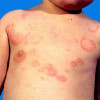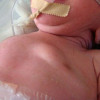
 IJCP Editorial Team
IJCP Editorial Team
Childhood Atopic Dermatitis and Risk of Non-Atopic Comorbid Conditions
Children and adolescents with atopic dermatitis (AD) are at high risk of developing multiple non-allergic comorbid conditions, in addition to allergic conditions, as per the findings of a study published in the Journal of The European Academy of Dermatology & Venereology.1,2
This retrospective observational cohort study utilized data of patients, aged ≤18 years, with confirmed AD from primary and specialist care registers in Sweden between 2007 and 2017 to assess their risk of developing various comorbid conditions, both allergic and non-allergic. Type 1 diabetes (T1D), endocrine and metabolic disorders, skeletal disorders, ocular disorders, infections, neurological disorders, psychiatric disorders, immunological and inflammatory disorders and malignancies were among the conditions assessed. Out of the 165,145 patients included in the study, 126,681 had mild to moderate AD, mean age 5.13 years at the time of enrolment, and 38,464 had severe AD, mean age, 6.33 years. They were matched 1:1 with an equal number of participants without AD selected randomly from the general population as controls. The study group was followed up till December 2018.
Compared to the control group, patients with AD were at a greater risk of developing comorbid conditions for all the categories of disease conditions evaluated, with the exception of T1D and skeletal disorders. Results showed that 36.6% of AD patients had developed at least one comorbid condition during the follow-up vs 28.5% in the control group. The most common comorbid conditions were hypersensitivity and allergic disorders, which occurred in 18.5% of patients in the AD group vs 10% of patients in the control group. The next most commonly occurring comorbid conditions were infections (18.35% vs 5.29%) followed by skeletal disorders (13.2% vs 9.65%).
Patients with AD were at least thrice more likely to develop hypersensitivity and allergic disorders vs control group with hazard ratio (HR) of 3.87. The risk for immunological and inflammatory disorders as well as malignancies was more than doubled with HRs of 2.36 and 2.53, respectively.
Additionally, patients with AD were at a higher risk of developing several comorbid conditions. Of these, 27.1% of the AD patients and 19.7% of non-AD group developed more than two comorbidities. Active AD (vs in remission) was associated with higher risk of comorbidity onset. As the severity of AD increased, the probability of developing a comorbidity increased.
AD constitutes a significant clinical burden in the affected children. This study shows that the risk of developing multiple comorbid conditions in addition to the atopic march is significantly increased in children with AD. The atopic march starts with AD and progresses to IgE-mediated food allergy, asthma and allergic rhinitis. Additionally, these findings demonstrated a positive correlation between the escalating severity of AD and the higher chances of the onset of comorbidity. AD is being recognized as a multiorgan disease. This study further adds to the growing evidence regarding this. Hence, it should be viewed as a systemic disease. Children with AD should be evaluated for other disease conditions and managed accordingly.
References
1. Laura von Kobyletzki, et al. Comorbidities in childhood atopic dermatitis: A population-based study. J Eur Acad Dermatol Venereol. 2023 Oct 12. doi: 10.1111/jdv.19569.
2. Ron Goldberg. Available at: https://www.dermatologyadvisor.com/home/topics/dermatitis/children-with-atopic-dermatitis-have-an-increased-risk-for-non-atopic-comorbidities/. Dated Nov. 21, 2023. Accessed on Nov. 30, 2023.

IJCP Editorial Team
Comprising seasoned professionals and experts from the medical field, the IJCP editorial team is dedicated to delivering timely and accurate content and thriving to provide attention-grabbing information for the readers. What sets them apart are their diverse expertise, spanning academia, research, and clinical practice, and their dedication to upholding the highest standards of quality and integrity. With a wealth of experience and a commitment to excellence, the IJCP editorial team strives to provide valuable perspectives, the latest trends, and in-depth analyses across various medical domains, all in a way that keeps you interested and engaged.




















Please login to comment on this article